Finding What Is Inaccessible: Antimicrobial Resistance Language Use among the One Health Domains
Abstract
1. Introduction
2. Results and Discussion
2.1. Language Use across the One Health Domains
2.2. Trends in “Antimicrobial Resistance” Language Use over Time
2.3. Trends in Acronym Use over Time
2.4. Trends in Language Use among the One Health Domains
2.5. Accessibility of AMR Articles, Publication Preferences, and Potential Biases among the One Health Domains
2.5.1. Non-Open/Restricted Access vs. Open Access Journals
2.5.2. Publication Preferences
2.5.3. Potential Biases among the One Health Domains
2.5.4. Implications for Accessing the Literature
2.6. Using Text Data Mining to Predict Patterns of Historical and Future Events
3. Materials and Methods
3.1. Open Access Data Collection
3.2. Non-Open Access Data Collection
3.3. Text Data Mining Processing
3.4. Data and Statistical Analysis
4. Conclusions
Supplementary Materials
Author Contributions
Funding
Institutional Review Board Statement
Informed Consent Statement
Data Availability Statement
Acknowledgments
Conflicts of Interest
References
- Van Puyvelde, S.; Deborggraeve, S.; Jacobs, J. Why the antibiotic resistance crisis requires a One Health approach. Lancet Infect. Dis. 2018, 18, 132–134. [Google Scholar] [CrossRef]
- Robinson, T.P.; Bu, D.P.; Carrique-Mas, J.; Fèvre, E.M.; Gilbert, M.; Grace, D.; Hay, S.I.; Jiwakanon, J.; Kakkar, M.; Kariuki, S.; et al. Antibiotic resistance is the quintessential One Health issue. Trans. R. Soc. Trop. Med. Hyg. 2016, 110, 377. [Google Scholar] [CrossRef]
- American Veterinary Medical Association. One Health: A New Professional Imperative; American Veterinary Medical Association: Schaumburg, IL, USA, 2008. [Google Scholar]
- Schwabe, C.W. Veterinary Medicine and Human Health; Williams & Wilkins: Philadelphia, PA, USA, 1967. [Google Scholar]
- Gibbs, E.P.J. Emerging zoonotic epidemics in the interconnected global community. Vet. Rec. 2005, 157, 673–679. [Google Scholar] [CrossRef] [PubMed]
- Mackenzie, J.S.; Smith, D.W. COVID-19: A novel zoonotic disease caused by a coronavirus from China: What we know and what we don’t. Microbiol. Aust. 2020, 41, 45. [Google Scholar] [CrossRef] [PubMed]
- Collignon, P.J.; McEwen, S.A. One Health—Its Importance in Helping to Better Control Antimicrobial Resistance. Trop. Med. Infect. Dis. 2019, 4, 22. [Google Scholar] [CrossRef]
- Aminov, R.I. A Brief History of the Antibiotic Era: Lessons Learned and Challenges for the Future. Front. Microbiol. 2010, 1, 134. [Google Scholar] [CrossRef]
- McManus, P.S.; Stockwell, V.O.; Sundin, G.W.; Jones, A.L. Antibiotic use in plant agriculture. Annu. Rev. Phytopathol. 2002, 40, 443–465. [Google Scholar] [CrossRef] [PubMed]
- Bauer, D.J. A History of the Discovery and Clinical Application of Antiviral Drugs. Br. Med. Bull. 1985, 41, 309–314. [Google Scholar] [CrossRef]
- Odds, F.C. Antifungal agents: Their diversity and increasing sophistication. Mycologist 2003, 17, 51–55. [Google Scholar] [CrossRef]
- Campbell, W.C. Lessons from the History of Ivermectin and Other Antiparasitic Agents. Annu. Rev. Anim. Biosci. 2016, 4, 1–14. [Google Scholar] [CrossRef]
- Mohr, K.I. History of Antibiotics Research. Curr. Top. Microbiol. Immunol. 2016, 398, 237–272. [Google Scholar]
- Witte, W. Selective pressure by antibiotic use in livestock. Int. J. Antimicrob. Agents 2000, 16 (Suppl. 1), S19–S24. [Google Scholar] [CrossRef]
- Kolár, M.; Urbánek, K.; Látal, T. Antibiotic selective pressure and development of bacterial resistance. Int. J. Antimicrob. Agents 2001, 17, 357–363. [Google Scholar] [CrossRef]
- Mainardi, J.-L.; Villet, R.; Bugg, T.D.; Mayer, C.; Arthur, M. Evolution of peptidoglycan biosynthesis under the selective pressure of antibiotics in Gram-positive bacteria. FEMS Microbiol. Rev. 2008, 32, 386–408. [Google Scholar] [CrossRef] [PubMed]
- Van Goethem, M.W.; Pierneef, R.; Bezuidt, O.K.I.; Van De Peer, Y.; Cowan, D.A.; Makhalanyane, T.P. A reservoir of “historical” antibiotic resistance genes in remote pristine Antarctic soils. Microbiome 2018, 6, 40. [Google Scholar] [CrossRef]
- Partridge, S.R.; Kwong, S.M.; Firth, N.; Jensen, S.O. Mobile Genetic Elements Associated with Antimicrobial Resistance. Clin. Microbiol. Rev. 2018, 31, e00088-17. [Google Scholar] [CrossRef] [PubMed]
- Sheehan, D.; Robertson, L.; Ormond, T. Comparison of language used and patterns of communication in interprofessional and multidisciplinary teams. J. Interprof. Care 2007, 21, 17–30. [Google Scholar] [CrossRef]
- Durso, L.M.; Cook, K.L. One Health and Antibiotic Resistance in Agroecosystems. Ecohealth 2018, 16, 414–419. [Google Scholar] [CrossRef]
- Ritter, M.A. Operating Room Environment. Clin. Orthop. Relat. Res. 1999, 369, 103. [Google Scholar] [CrossRef]
- Yassi, A.; Kjellström, T.; de Kok, T.; Guidotti, T.L. Basic Environmental Health; Oxford University Press: Oxford, UK, 2001. [Google Scholar]
- One Health Initiative. Available online: https://onehealthinitiative.com/about/ (accessed on 9 April 2020).
- Mendelson, M.; Balasegaram, M.; Jinks, T.; Pulcini, C.; Sharland, M. Antibiotic resistance has a language problem. Nature 2017, 545, 23–25. [Google Scholar] [CrossRef]
- Léger, A.; Stärk, K.D.C.; Rushton, J.; Nielsen, L.R. A One Health Evaluation of the University of Copenhagen Research Centre for Control of Antibiotic Resistance. Front. Vet. Sci 2018, 5, 194. [Google Scholar] [CrossRef] [PubMed]
- UN Announces Interagency Group to Coordinate Global Fight against Antimicrobial Resistance. Available online: https://news.un.org/en/story/2017/03/553412-un-announces-interagency-group-coordinate-global-fight-against-antimicrobial (accessed on 26 October 2020).
- Cheruvelil, K.S.; Soranno, P.A. Data-intensive ecological research is catalyzed by open science and team science. BioScience 2018, 68, 813–822. [Google Scholar] [CrossRef]
- Jakobsen, C.H.; McLaughlin, W.J. Communication in ecosystem management: A case study of cross-disciplinary integration in the assessment phase of the interior Columbia Basin Ecosystem Management Project. Environ. Manag. 2004, 33, 591–605. [Google Scholar] [CrossRef] [PubMed]
- Van Swol, L.M.; Kane, A.A. Language and group processes: An integrative, interdisciplinary review. Small Group Res. 2019, 50, 3–38. [Google Scholar] [CrossRef]
- Wray, A. The language of dementia science and the science of dementia language. J. Lang. Soc. Psychol. 2017, 36, 80–95. [Google Scholar] [CrossRef]
- Destoumieux-Garzón, D.; Mavingui, P.; Boetsch, G.; Boissier, J.; Darriet, F.; Duboz, P.; Fritsch, C.; Giraudoux, P.; Le Roux, F.; Morand, S.; et al. The One Health Concept: 10 Years Old and a Long Road Ahead. Front. Vet. Sci. 2018, 5, 14. [Google Scholar] [CrossRef]
- Krockow, E.M. Nomen est omen: Why we need to rename ‘antimicrobial resistance’. JAC Antimicrob. Resist. 2020, 2. [Google Scholar] [CrossRef]
- Glossary of Terms Related to Antibiotic Resistance |NARMS| CDC. Available online: https://www.cdc.gov/narms/resources/glossary.html (accessed on 13 July 2020).
- Katrime Integrated Health Glossary of Terms: Antimicrobial Resistance. Available online: https://nccid.ca/publications/glossary-terms-antimicrobial-resistance/ (accessed on 13 July 2020).
- Encyclopaedia. Available online: https://revive.gardp.org/resources/encyclopaedia/ (accessed on 26 October 2020).
- Davis, M.F.; Rankin, S.C.; Schurer, J.M.; Cole, S.; Conti, L.; Rabinowitz, P. COHERE Expert Review Group Checklist for One Health Epidemiological Reporting of Evidence (COHERE). One Health 2017, 4, 14–21. [Google Scholar] [CrossRef]
- Kelly, R.; Zoubiane, G.; Walsh, D.; Ward, R.; Goossens, H. Public funding for research on antibacterial resistance in the JPIAMR countries, the European Commission, and related European Union agencies: A systematic observational analysis. Lancet Infect. Dis. 2016, 16, 431. [Google Scholar] [CrossRef]
- The AMR Fund. Available online: https://www.cdcfoundation.org/what/programs/amr-fund (accessed on 26 February 2021).
- Manure & Nutrient Management Programs. Available online: https://nifa.usda.gov/program/manure-nutrient-management-programs (accessed on 9 September 2020).
- When and How to Comply. Available online: https://publicaccess.nih.gov/ (accessed on 9 September 2020).
- MeSH. Available online: https://www.ncbi.nlm.nih.gov/mesh/?term=antibiotic+resistance (accessed on 26 October 2020).
- Fineberg, H.V. Pandemic preparedness and response—Lessons from the H1N1 influenza of 2009. N. Engl. J. Med. 2014, 370, 1335–1342. [Google Scholar] [CrossRef]
- CDC. Ten Years of Gains: A Look Back at Progress Since the 2009 H1N1 Pandemic. Available online: https://www.cdc.gov/flu/spotlights/2018-2019/decade-since-h1n1-pandemic.html (accessed on 9 September 2020).
- Congress Approves $7.65 Billion for Pandemic Flu Response. Available online: https://www.cidrap.umn.edu/news-perspective/2009/06/congress-approves-765-billion-pandemic-flu-response (accessed on 9 September 2020).
- Rawson, T.M.; Moore, L.S.P.; Castro-Sanchez, E.; Charani, E.; Davies, F.; Satta, G.; Ellington, M.J.; Holmes, A.H. COVID-19 and the potential long-term impact on antimicrobial resistance. J. Antimicrob. Chemother. 2020, 75, 1681–1684. [Google Scholar] [CrossRef]
- Khor, W.P.; Olaoye, O.; D’Arcy, N.; Krockow, E.M.; Elshenawy, R.A.; Rutter, V.; Ashiru-Oredope, D. The Need for Ongoing Antimicrobial Stewardship during the COVID-19 Pandemic and Actionable Recommendations. Antibiotics 2020, 9, 904. [Google Scholar] [CrossRef]
- Studies: Hand Sanitizers Kill COVID-19 Virus, E-Consults Appropriate. Available online: https://www.cidrap.umn.edu/news-perspective/2020/04/studies-hand-sanitizers-kill-covid-19-virus-e-consults-appropriate (accessed on 9 September 2020).
- Getahun, H.; Smith, I.; Trivedi, K.; Paulin, S.; Balkhy, H.H. Tackling antimicrobial resistance in the COVID-19 pandemic. Bull. World Health Organ. 2020, 98, 442. [Google Scholar] [CrossRef] [PubMed]
- Nieuwlaat, R.; Mbuagbaw, L.; Mertz, D.; Burrows, L.; Bowdish, D.M.E.; Moja, L.; Wright, G.D.; Schünemann, H.J. COVID-19 and Antimicrobial Resistance: Parallel and Interacting Health Emergencies. Clin. Infect. Dis. 2020. [Google Scholar] [CrossRef]
- Richard Smith-Unna, P.M.-R. The ContentMine Scraping Stack: Literature-scale Content Mining with Community-maintained Collections of Declarative Scrapers. D-Lib Mag. 2014, 20. [Google Scholar] [CrossRef]
- The Europe PMC Consortium. Europe PMC: A full-text literature database for the life sciences and platform for innovation. Nucleic Acids Res. 2015, 43, D1042. [Google Scholar] [CrossRef] [PubMed]
- Buyalskaya, A.; Gallo, M.; Camerer, C.F. The golden age of social science. Proc. Natl. Acad. Sci. USA 2021, 118. [Google Scholar] [CrossRef]
- Collobert, R.; Weston, J.; Bottou, L.; Karlen, M.; Kavukcuoglu, K.; Kuksa, P. Natural Language Processing (Almost) from Scratch. J. Mach. Learn. Res. 2011, 12, 2493–2537. [Google Scholar]
- Manyi-Loh, C.; Mamphweli, S.; Meyer, E.; Okoh, A. Antibiotic Use in Agriculture and Its Consequential Resistance in Environmental Sources: Potential Public Health Implications. Mol. A J. Synth. Chem. Nat. Prod. Chem. 2018, 23, 795. [Google Scholar] [CrossRef]
- Tableau (version. 9.1). J. Med. Libr. Assoc. 2016, 104, 182–183. [CrossRef]
- Shannon, P.; Markiel, A.; Ozier, O.; Baliga, N.S.; Wang, J.T.; Ramage, D.; Amin, N.; Schwikowski, B.; Ideker, T. Cytoscape: A software environment for integrated models of biomolecular interaction networks. Genome Res. 2003, 13, 2498–2504. [Google Scholar] [CrossRef] [PubMed]
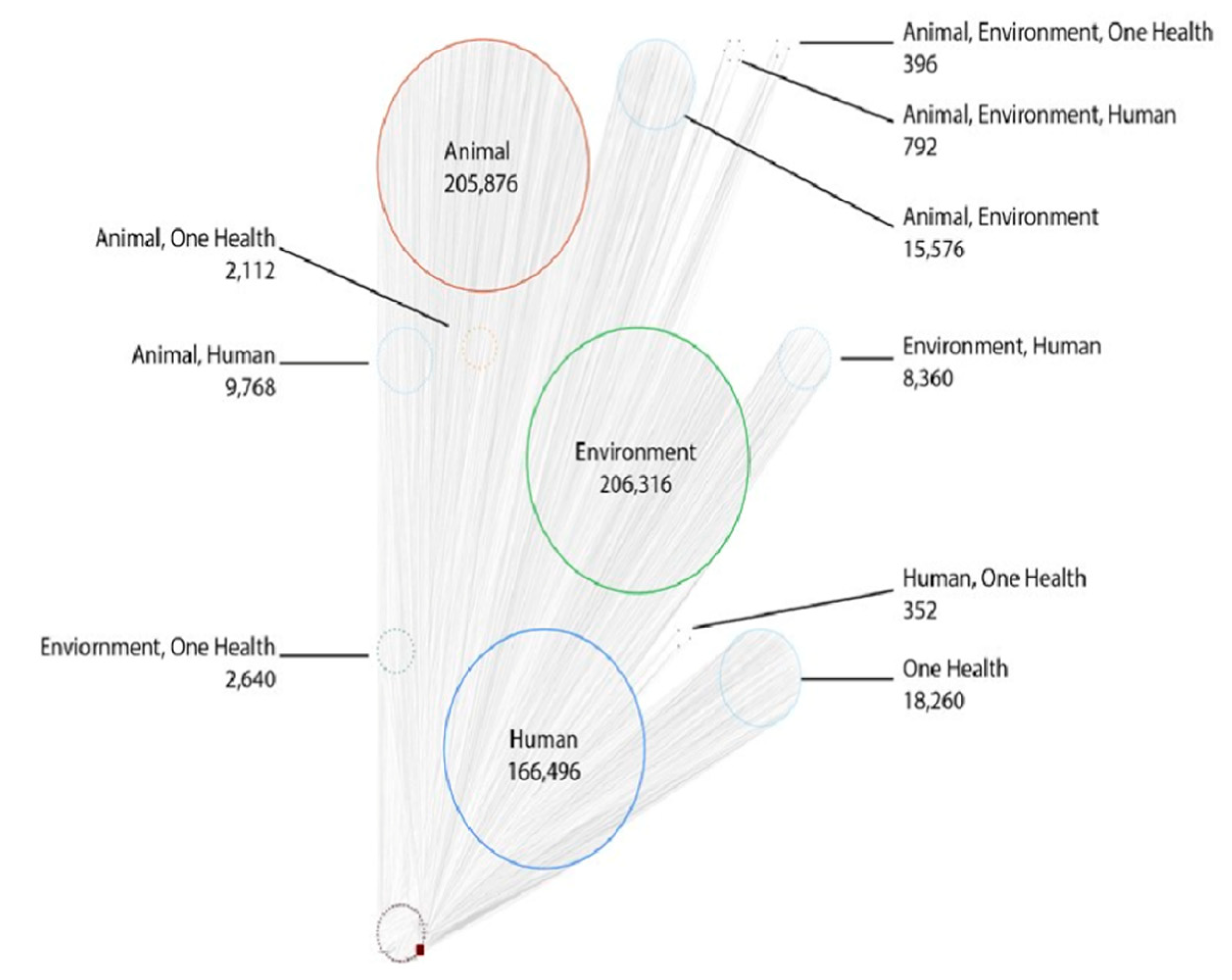
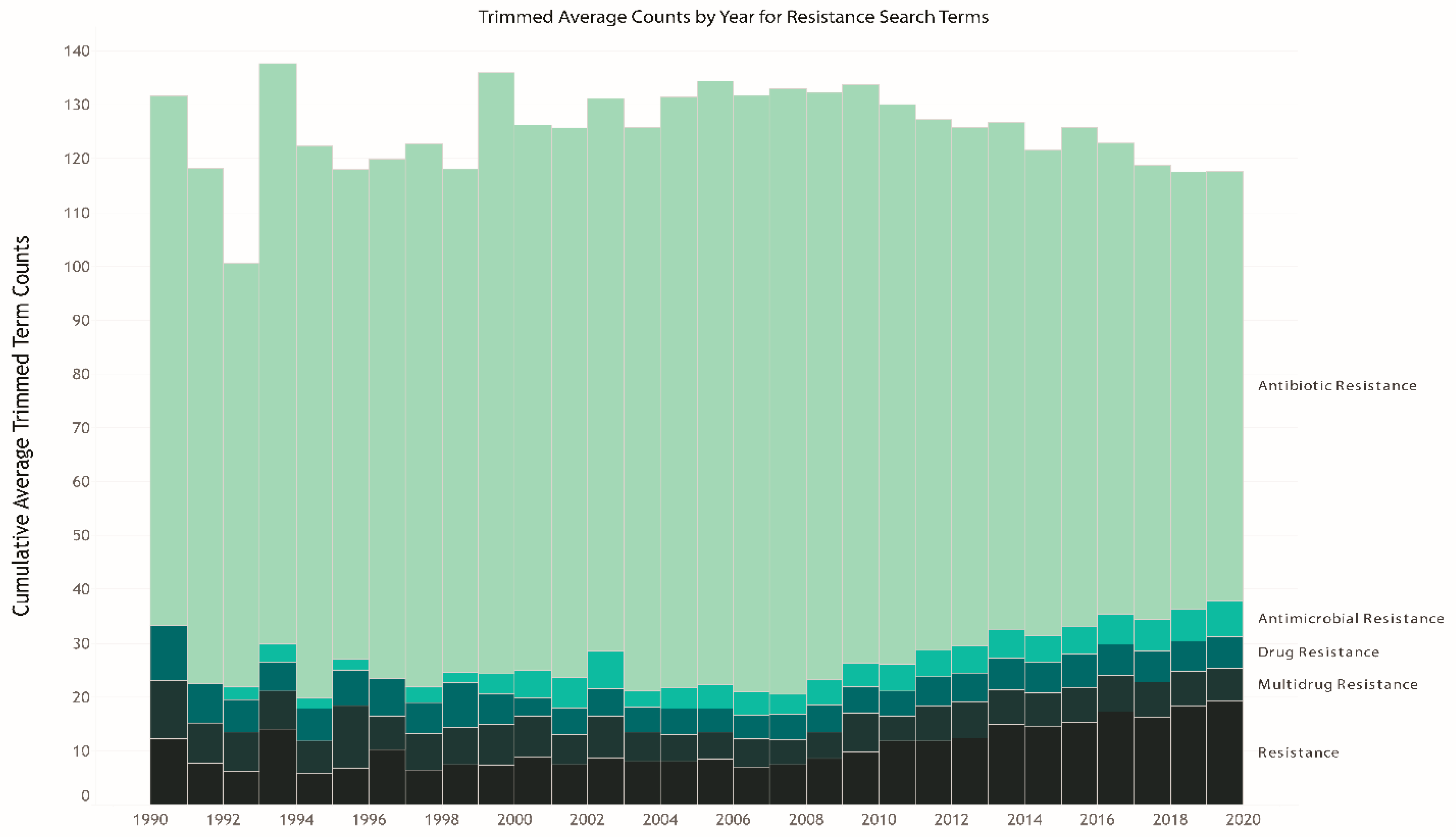
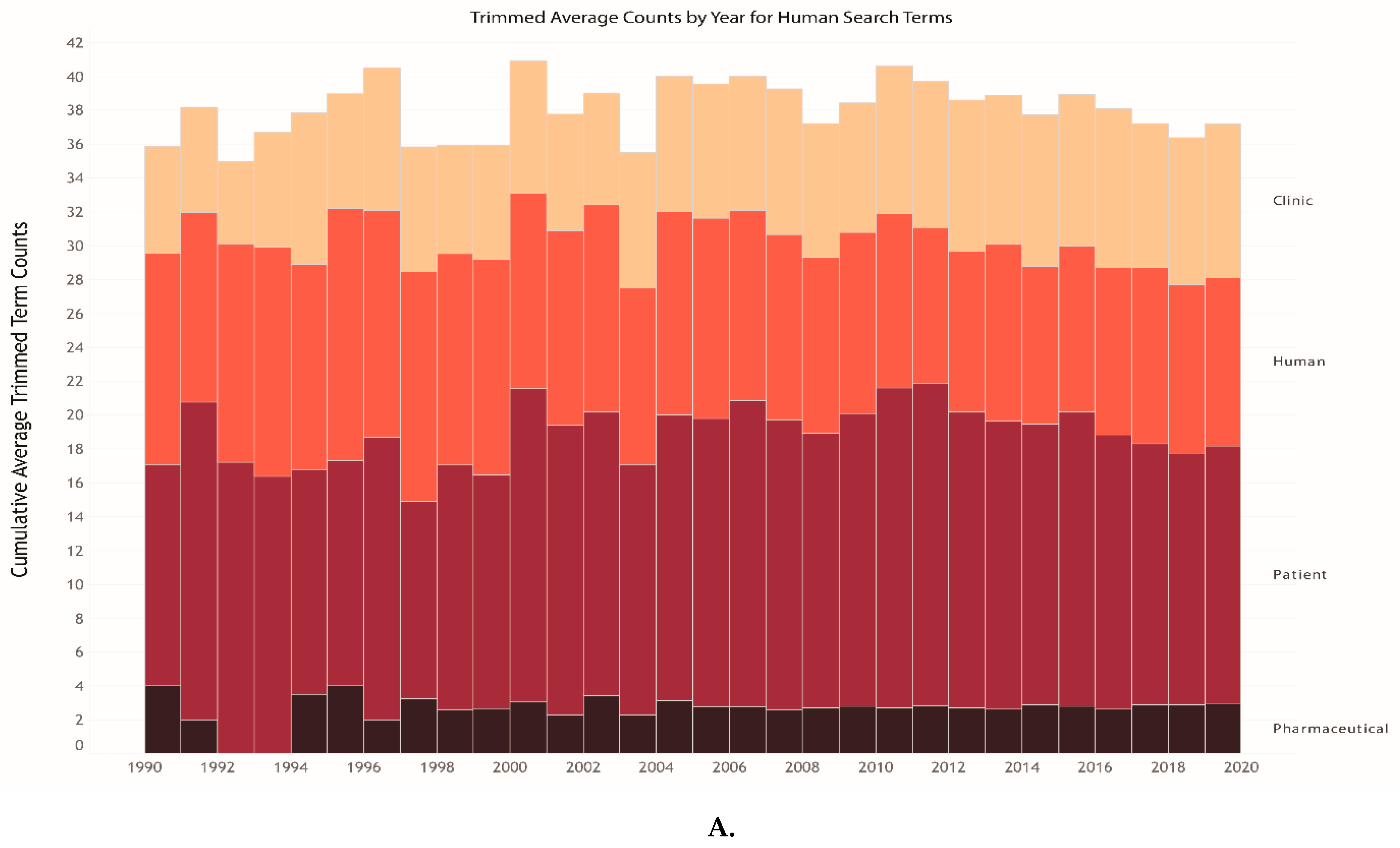
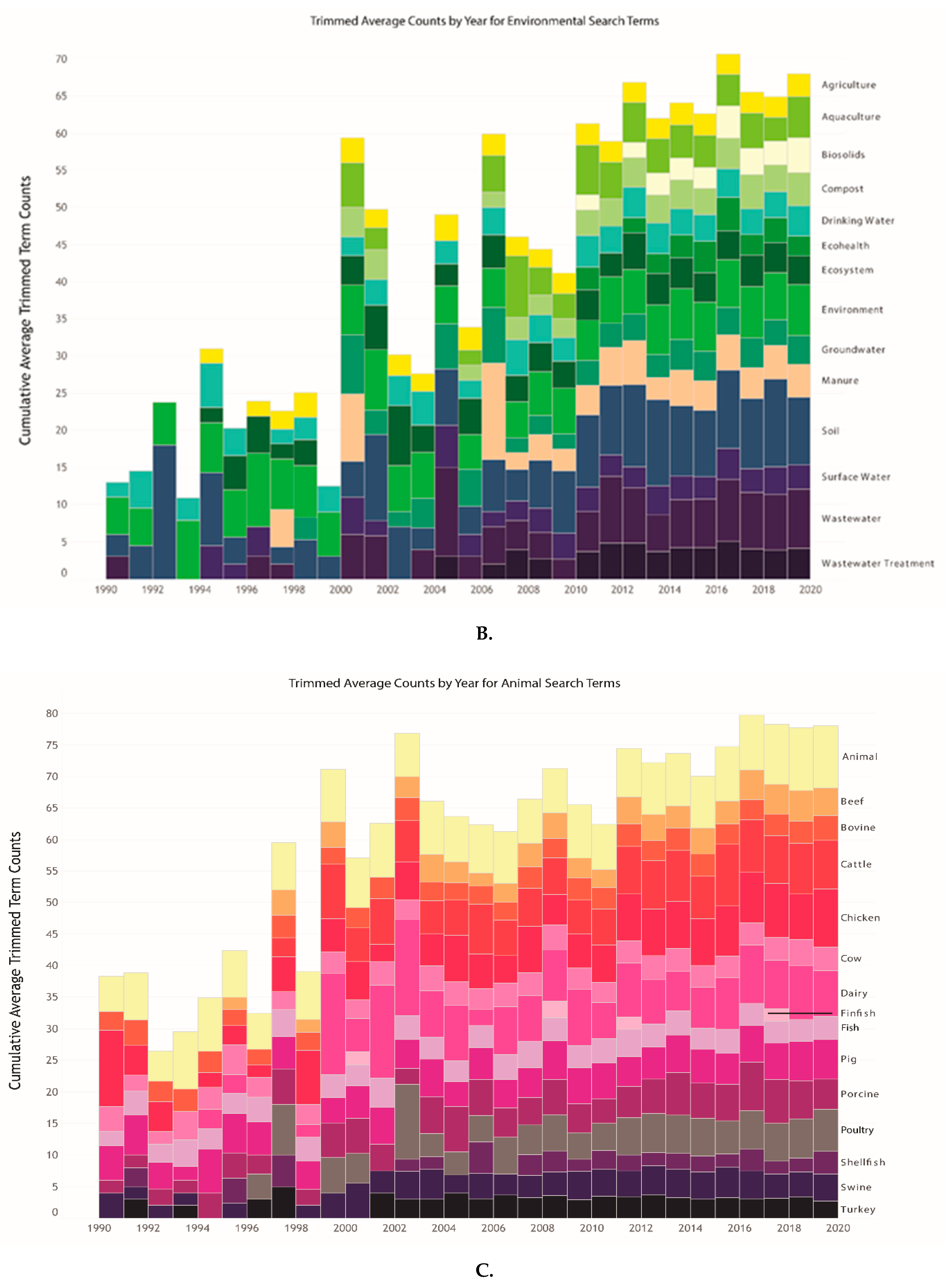
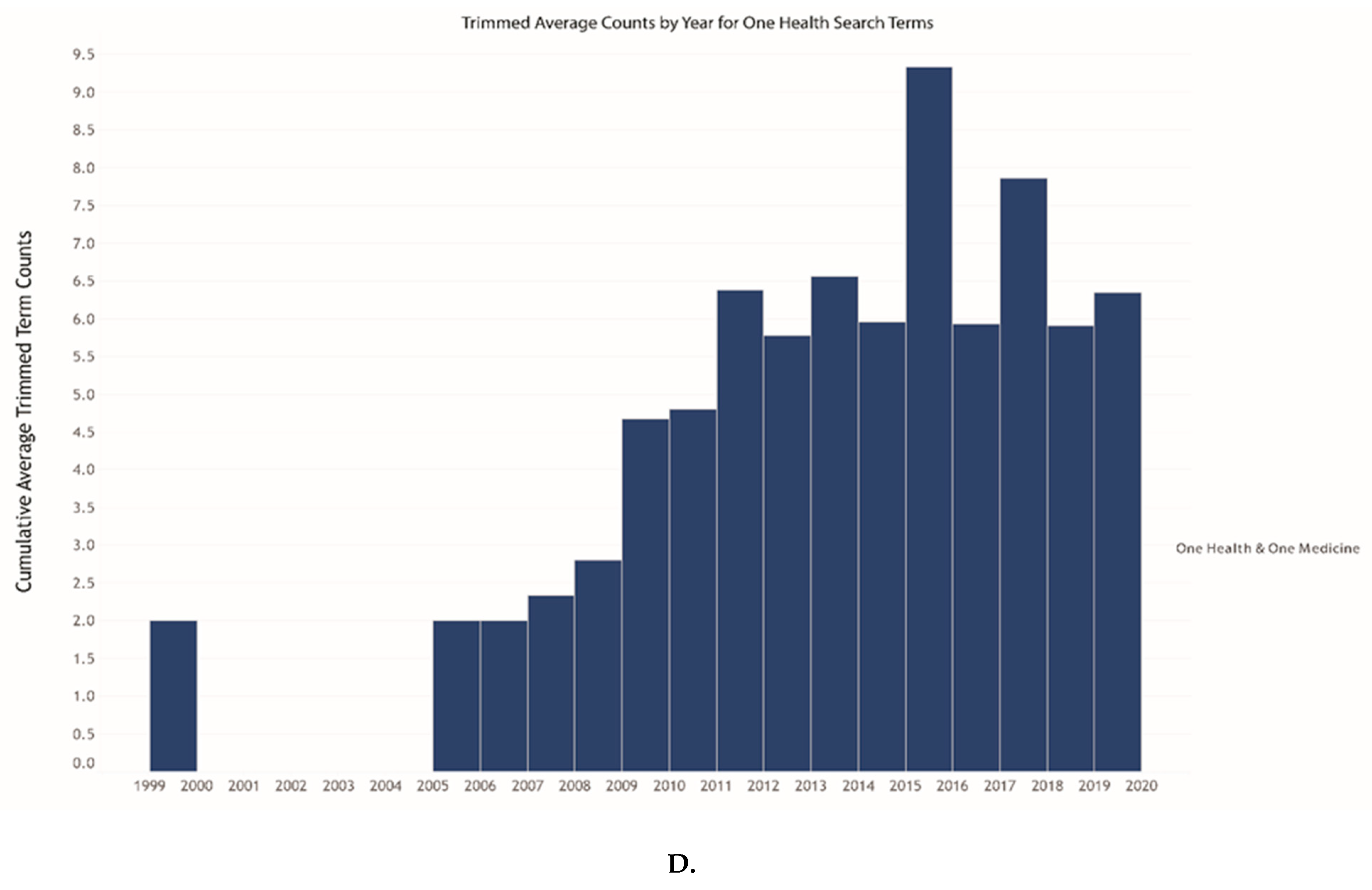
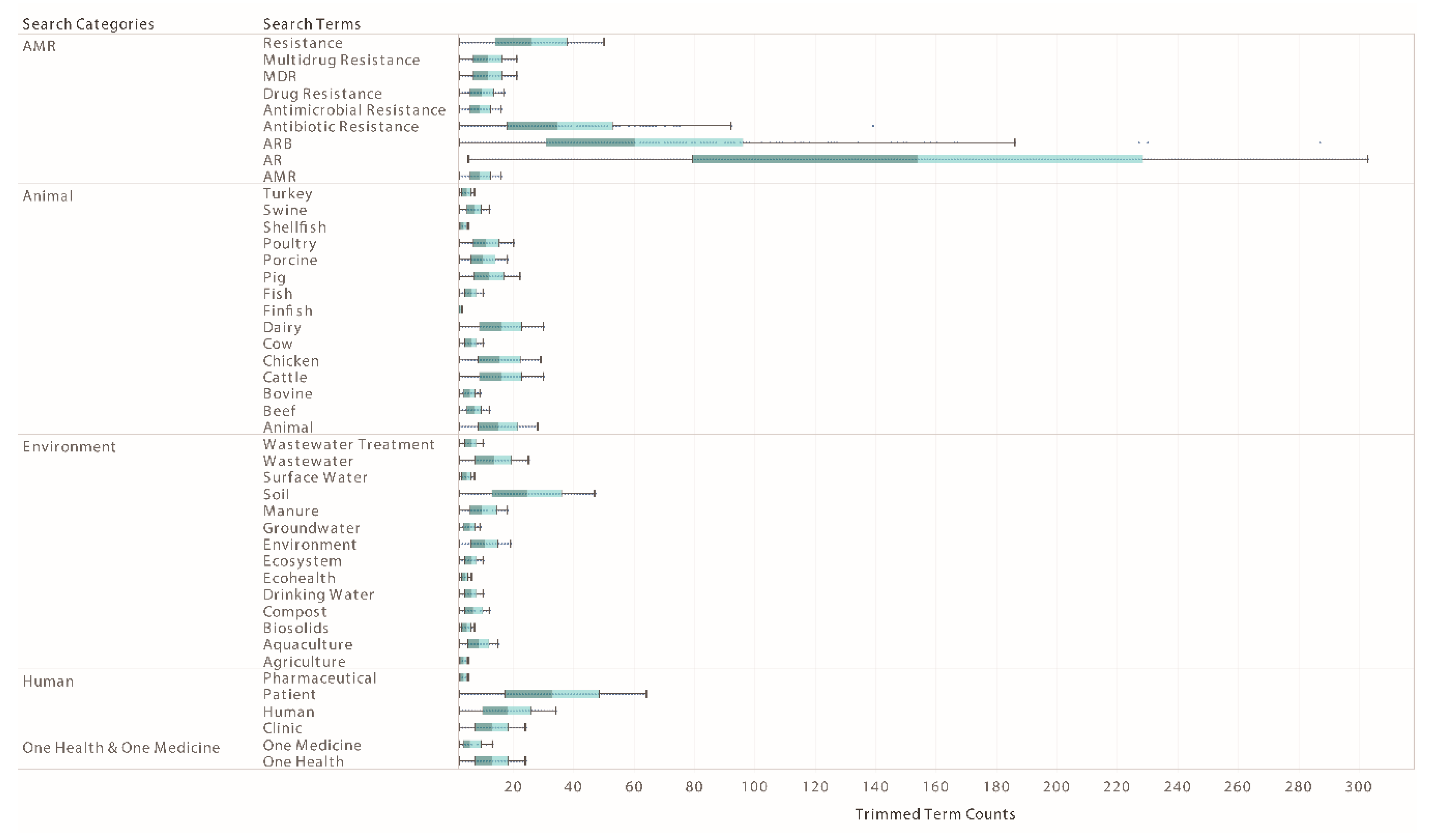
| Term Bin | Human | Animal | Environment | One Health |
|---|---|---|---|---|
| Search Terms | Human, patient, pharmaceutical, clinic 1 | Animal, dairy, cow, beef, cattle, poultry, swine, chicken, pig, turkey, fish, porcine, bovine, finfish, shellfish | Ecosystem, ecohealth, environment, soil, agriculture, wastewater, drinking water, groundwater, surface water, compost, manure, biosolids, aquaculture, wastewater treatment | One health, one medicine |
| AND | antimicrobial resistance, antibiotic resistance, drug resistance, multi-drug resistance, resistance, AMR, ARB, AR, MDR | |||
| NOT | Herbicide, pesticide, disease resistance | |||
Publisher’s Note: MDPI stays neutral with regard to jurisdictional claims in published maps and institutional affiliations. |
© 2021 by the authors. Licensee MDPI, Basel, Switzerland. This article is an open access article distributed under the terms and conditions of the Creative Commons Attribution (CC BY) license (https://creativecommons.org/licenses/by/4.0/).
Share and Cite
Wind, L.L.; Briganti, J.S.; Brown, A.M.; Neher, T.P.; Davis, M.F.; Durso, L.M.; Spicer, T.; Lansing, S. Finding What Is Inaccessible: Antimicrobial Resistance Language Use among the One Health Domains. Antibiotics 2021, 10, 385. https://doi.org/10.3390/antibiotics10040385
Wind LL, Briganti JS, Brown AM, Neher TP, Davis MF, Durso LM, Spicer T, Lansing S. Finding What Is Inaccessible: Antimicrobial Resistance Language Use among the One Health Domains. Antibiotics. 2021; 10(4):385. https://doi.org/10.3390/antibiotics10040385
Chicago/Turabian StyleWind, Lauren L., Jonathan S. Briganti, Anne M. Brown, Timothy P. Neher, Meghan F. Davis, Lisa M. Durso, Tanner Spicer, and Stephanie Lansing. 2021. "Finding What Is Inaccessible: Antimicrobial Resistance Language Use among the One Health Domains" Antibiotics 10, no. 4: 385. https://doi.org/10.3390/antibiotics10040385
APA StyleWind, L. L., Briganti, J. S., Brown, A. M., Neher, T. P., Davis, M. F., Durso, L. M., Spicer, T., & Lansing, S. (2021). Finding What Is Inaccessible: Antimicrobial Resistance Language Use among the One Health Domains. Antibiotics, 10(4), 385. https://doi.org/10.3390/antibiotics10040385






